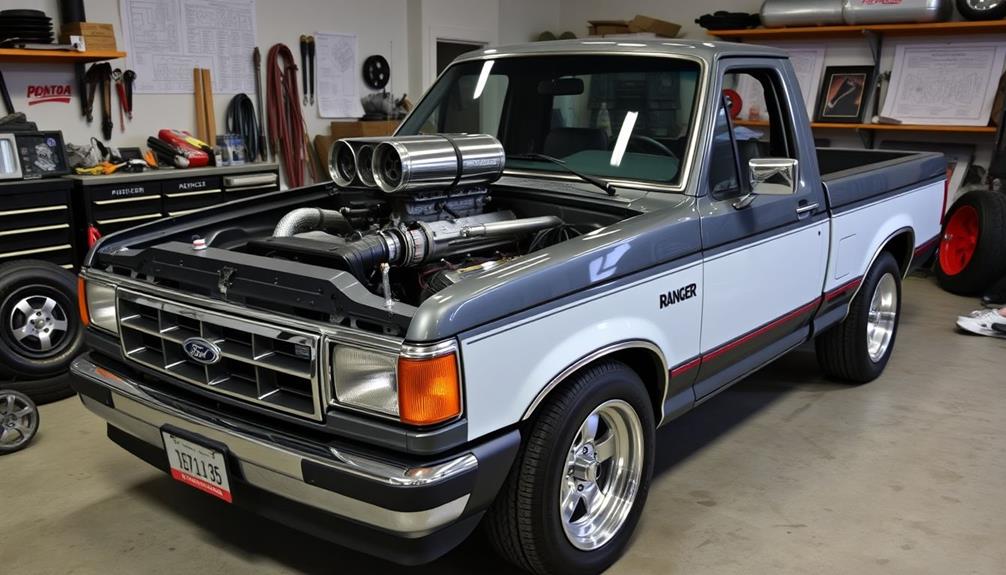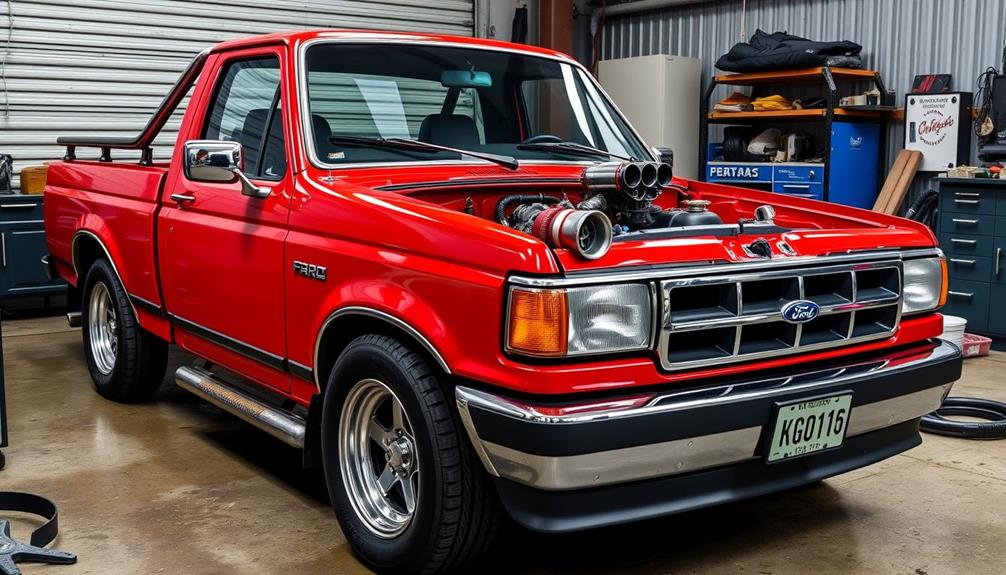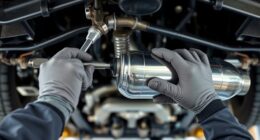Tuning your 1992 Ford Ranger can breathe new life into your classic truck, turning it into a modern powerhouse. Start by replacing spark plugs and upgrading your throttle body for improved acceleration. Enhance airflow with a high-flow K&N filter and install shorty headers for better exhaust flow. Consider tuning chips to release significant horsepower gains. For serious boosts, think about camshaft and head upgrades. Keep an eye on cost-benefit analysis to guarantee your upgrades align with your goals. Curious about which modifications yield the best results? There's plenty more to explore that can elevate your Ranger's performance.
Key Takeaways
- Upgrade stock components like spark plugs, wires, and fuel filters for improved ignition efficiency and fuel flow in your 1992 Ford Ranger.
- Installing a BBK 66MM throttle body and shorty headers enhances acceleration and exhaust flow, significantly boosting horsepower.
- Utilize tuning chips like Jaybird or SCT for real-time adjustments, potentially increasing output to 220-240 hp with proper modifications.
- Consider a nitrous oxide kit or T-88 turbocharger for substantial performance gains, pushing power levels toward 400 horsepower at the flywheel.
- Regular maintenance and careful tuning can enhance fuel efficiency while maximizing the performance of your classic truck.
Initial Modifications for Power
Enhancing your Ford Ranger's power begins with some straightforward modifications that can make a noticeable difference.
You'll want to start by focusing on the initial modifications for power that can easily ramp up your engine's performance. One effective step is replacing the stock spark plugs and wires with high-quality Motorcraft parts. This simple upgrade can lead to improved ignition efficiency and better power output from your 4.0L engine.
Next, don't overlook the importance of a fuel filter and fuel injection service. This maintenance guarantees ideal fuel flow, which is vital for maintaining the engine's performance. Upgrading the PCV valve and O2 sensor also contributes greatly to overall efficiency and power.
For an even bigger boost, consider installing a BBK 66MM throttle body. This modification enhances acceleration and responsiveness, making your Ranger more enjoyable to drive.
While you're at it, swapping in a Dynomax 17730 muffler can improve exhaust flow and add horsepower.
Upgrading Intake and Exhaust

Upgrading the intake and exhaust systems on your Ford Ranger can greatly boost performance and efficiency. By enhancing airflow and reducing back pressure, you'll notice improved throttle response and acceleration.
Here are some key upgrades to take into account:
- High-flow K&N filter: This enhances airflow without the risks of aftermarket cold air intakes, which mightn't yield considerable benefits on a stock system.
- Shorty headers: While they can replace stock manifolds and improve exhaust flow, keep in mind that the gains may be modest unless combined with other modifications.
- Dynomax 17730 muffler: Upgrading to this muffler can noticeably increase power by enhancing exhaust flow and minimizing back pressure.
For an even greater impact on acceleration, think about installing a BBK 66MM throttle body. This upgrade appreciably improves throttle response and overall engine performance.
Don't forget, proper tuning after upgrading intake and exhaust is essential. Adjustments can optimize your Ford Ranger's performance and prevent issues related to engine longevity.
With these enhancements, your classic truck can truly feel like a modern powerhouse.
Engine Tuning Options

After boosting your Ford Ranger's intake and exhaust systems, it's time to investigate engine tuning options that can take your performance to the next level. One of the most effective ways to enhance your truck's power is through engine tuning chips, like the Jaybird or Quarterhorse. These tuning chips are specifically designed to optimize your Ford Ranger’s engine performance by adjusting various parameters such as ignition timing, fuel delivery, and turbo boost levels. With the right ford ranger tuning chip, you can unleash additional horsepower and torque, improve fuel efficiency, and enhance throttle response. Plus, many tuning chips can be easily installed at home with basic tools, making it a simple and cost-effective way to boost your Ford Ranger’s performance.
These chips let you make real-time adjustments to your engine's parameters, potentially increasing your Ranger's output from the stock 145-155 hp to an impressive 220-240 hp.
However, be cautious—while tuning chips can improve performance, they may also risk reducing engine longevity and cause issues like pinging. For substantial gains, consider pairing these chips with thorough modifications, such as camshaft upgrades and head porting.
Additionally, tuning adjustments can optimize shift points and enhance the torque converter lock-up, leading to better acceleration.
Using an SCT tuner in conjunction with professional services, like those offered by Mike Troyer, can yield impressive improvements in both horsepower and fuel efficiency.
Long-term Engine Upgrades

When considering long-term engine upgrades for your 1992 Ford Ranger, you'll want to evaluate the potential performance gains against the costs involved.
Upgrading components like the cam and head can boost horsepower considerably, but weighing the benefits of a complete engine swap might save you money in the long run.
It's essential to analyze these factors to guarantee your investment leads to the desired outcomes.
Engine Modification Considerations
Tuning your 1992 Ford Ranger's engine can greatly enhance its performance and longevity, but careful consideration is vital.
When planning modifications, you should weigh the benefits against the costs. Here are a few key engine modification considerations:
- Power Output: The stock 4.0L engine produces 145-155 hp, but with proper upgrades, you can push it to 220-240 hp.
- Component Upgrades: Consider enhancing components like camshafts, cylinder heads, and valve inserts to boost longevity and performance.
- Fuel System: Upgrading your fuel system to handle increased fuel pressure is essential for maximizing power gains.
As you plan your modifications, keep in mind that thorough upgrades often yield the best results.
While V8 swaps or 2.3L turbo conversions can be more cost-effective, extensive modifications to your existing engine may be necessary for significant power increases.
Make sure you conduct a detailed cost-benefit analysis; extensive work and investment in parts and labor are often required for those substantial gains.
Balancing your goals with your budget will lead to the most satisfying results for your Ranger project.
Performance Gains Analysis
Performance gains from long-term engine upgrades on your 1992 Ford Ranger can be significant, transforming your vehicle into a powerful machine. The stock 4.0L engine, producing 145-155 hp, can potentially reach 220-240 hp with the right modifications. Upgrading components like heads, camshafts, and improving airflow is essential for pushing beyond stock capabilities.
However, be mindful of longevity concerns. Modifications can lead to issues like receding valves, making valve inserts an important upgrade. Your performance gains analysis should consider a thorough approach, including thorough engine work and tuning. With the right upgrades, achieving around 400 horsepower at the flywheel is possible.
Here's a quick overview of potential power gains:
| Upgrade Component | Stock HP | Potential HP |
|---|---|---|
| Stock 4.0L Engine | 145-155 | 220-240 |
| Heads & Camshafts | 155 | 200-220 |
| Complete Upgrade | 155 | 400 |
While many enthusiasts lean toward V8 or 2.3L turbo swaps for significant power gains, a well-planned upgrade can also yield impressive results.
Cost-Benefit Evaluation
Upgrading the engine of your 1992 Ford Ranger can be a tempting venture, especially with the promise of increased horsepower. However, before diving in, you need to conduct a thorough cost-benefit evaluation. Consider the following factors:
– Power Gains: Upgrading from the stock 4.0L engine could boost your power from 145-155 hp to around 220-240 hp with the right modifications.
Additionally, understanding your financial health can help you make informed decisions about whether to proceed with these enhancements.
- Financial Investment: Significant upgrades can be costly. You might find that V8 or 2.3L turbo swaps offer a more economical route for improved performance.
- Longevity and Maintenance: Issues like receding valves could lead to additional costs, such as valve inserts, which impact your overall budget.
Weighing these elements will help you understand whether the potential power gains justify the financial outlay.
While installing a BBK 66MM throttle body and an upgraded exhaust system can enhance your Ranger's performance, it's vital to assess your return on investment.
A well-planned performance upgrade should align with your long-term goals and budget, ensuring that you're not just chasing horsepower but also making a smart financial decision.
Performance Statistics Overview

When it comes to evaluating the capabilities of the 1992 Ford Ranger, the stock 4.0L SOHC engine serves as a solid foundation, achieving a quarter mile time of around 15.98 seconds. This serves as your baseline when considering various performance enhancements.
With the right tuning and modifications, you can considerably increase this truck's power and speed. For instance, adding a nitrous oxide kit can slice quarter mile times down by as much as 2.15 seconds, while bolt-on modifications can reduce those times by around 1.56 seconds.
If you're willing to go further, installing a T-88 turbocharger could push the Ranger's output to a remarkable 400 horsepower at the flywheel. This performance statistics overview highlights the potential for boosting your truck's capabilities, making it not just a classic but a formidable competitor on the track.
To track your improvements, remember that you can calculate quarter-mile times by multiplying your 1/8 mile times by 1.5832. This method gives you clear insights into how your modifications are enhancing performance, ensuring you can enjoy a truly dynamic driving experience.
Community Insights on Tuning

Tuning your 1992 Ford Ranger can be an exhilarating journey filled with camaraderie and shared knowledge among enthusiasts. Engaging with the community opens doors to invaluable insights that can elevate your truck's performance.
Here are some key takeaways you'll find in these circles:
- Bolt-On Modifications: Upgrading your exhaust system and adding tuning chips can lead to impressive power gains.
- Real-Time Adjustments: Tools like Jaybird and Quarterhorse are popular for making effective tuning adjustments on the fly.
- Performance Parts: High-performance components, such as Motorcraft spark plugs and wires, not only boost power but also enhance reliability.
Joining online forums or local clubs is a fantastic way to share experiences and troubleshoot any issues you might encounter.
Many community members have reported success with performance valve body upgrades that enhance the responsiveness of the Ranger's 5-speed manual transmission.
By tapping into these community insights, you'll find support and innovative tuning strategies that can transform your classic truck into a modern powerhouse.
Fuel Efficiency Considerations

While enhancing your 1992 Ford Ranger for performance, it's important to keep fuel efficiency in mind. Upgrading to higher octane fuel, like 93, can boost your fuel economy remarkably—some users report increases from 14 mpg to 16 mpg with tuning adjustments.
Additionally, using no Ethanol 91 gasoline has shown to enhance both performance and efficiency for your Ranger. It's also advantageous to think about natural remedies alongside conventional medications for overall well-being while driving.
Engine tuning modifications, such as performance valve bodies, can also improve transmission performance, leading to better fuel efficiency whether you're driving at part-throttle or wide-open throttle.
However, it's necessary to strike a balance between performance upgrades and utility; certain modifications may inadvertently increase fuel consumption if not carefully managed.
Regular maintenance plays a significant role in maintaining ideal fuel efficiency, especially in the older 4.0L V6 engine. Replacing spark plugs and performing fuel injection services can keep your engine running smoothly, ensuring you get the most out of every drop of fuel.
Frequently Asked Questions
Are 92 Ford Rangers Reliable?
Yes, 92 Ford Rangers are reliable. With proper maintenance, you'll find they often exceed 200,000 miles. Their durable build and easy access to parts make repairs straightforward, ensuring your truck stays dependable for years.
What Is the Best Year for Ford Ranger Pickups?
When considering the best year for Ford Ranger pickups, you might find the 1997 model stands out. It combines improved safety features with reliability, making it an excellent choice for both performance and everyday use.
What Does the PCM Do in a Ford Ranger?
Your Ford Ranger's PCM is like a brain, orchestrating engine performance with precision. It fuels your truck's potential by adjusting fuel injection and timing, ensuring you experience peak power while keeping emissions in check. It's essential!
How Much Was a Ford Ranger in 1992?
In 1992, you'd find a Ford Ranger starting around $10,000 for the base model, while higher trims like the XLT could reach about $15,000, depending on options and configurations you selected.
Conclusion
As you rev up your 1992 Ford Ranger, feel the thrill of modern power coursing through its classic frame. Picture the roar of a finely-tuned engine as you navigate winding roads, leaving onlookers in awe. With each upgrade, you transform nostalgia into exhilarating performance, forging a bond between the past and the present. So, grab those tools, embrace the journey, and release the beast within your beloved truck—adventure awaits with every mile you conquer!










